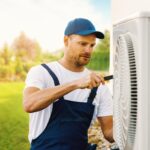
Signs Your HVAC System Needs Repairs Before It’s Too Late
Your HVAC system plays a crucial role in keeping your home comfortable year-round, but like any mechanical system, it requires
You just finished a strenuous workout and your anxious to take a nice hot shower to relax your sore muscles. But when you turn on the water, it’s cold! It’s time to troubleshoot your water heater. You know how important home maintenance is, but do you know what to do or how to do it?
Fortunately, we’re going to help you with this today. Namely, since you’re not an expert on electric water heaters, we’ll share our expert knowledge with you!
Below is a complete checklist for how to troubleshoot common water heater issues. These issues include leaks, water temperature problems, and smelly/discolored water.
This guide explains why these problems happen, how you can fix them, and when to call professional help. To learn what you need to know, keep reading.
Before you attempt any troubleshooting steps, first turn off your water heater. Additionally, switch off the water heater’s power source from your circuit breaker. Otherwise, the water combined with electricity can lead to a fatal electric shock.
Also, know that the heating elements, and the water in the water tank, may be hot for several hours. Thus, you need to give the deactivated water heater several hours to cool down before troubleshooting.
There are many different water heater problems that affect your water temperature. Here are a few that you might be experiencing.
You’ll have to ignore our safety warning for this step. That is, you need the power on to check if the water heater/heating elements are working.
First, check indicator lights, digital displays, and any other indications that the water heater is receiving power. If it isn’t, try turning it on.
Then check that the water heater circuit is turned on in your circuit breaker. If the water heater won’t turn on or it keeps tripping the circuit breaker, call for professional help.
Next, if it does have power, make sure the heating element thermostats are on and properly set. The only remaining cause is a faulty heating element.
Without touching the heating elements, feel whether they’re radiating heat. If they aren’t, it’s time to search for “water heater repair near me.”
Check the heating elements as above. If they’re working fine, the water heater is probably too small for your house.
You can try conserving hot water. Otherwise, get the water heater replaced.
If the water’s always too hot, adjust the thermostat settings. The most commonly accepted setting is between 115 and 125 degrees.
Water heater noise is usually caused by sediment buildup. Flush the tank and clean out the sediment to solve this.
These are common symptoms of a failing anode rod or some other corrosion inside your water tank. It’s best that you let a professional fix these problems.
Check all valves, pipes, hoses, and connections for the source of the leaks. Tighten all connections and replace leaky components. If this doesn’t work, the tank probably needs replacing due to corrosion.
Keep this home maintenance guide bookmarked so that you don’t forget these tips. Use this checklist whenever you need to troubleshoot and fix your broken water heater so you don’t get stuck with a cold shower again!
Lastly, if you ever need 24/7 water heater repair in Minnesota, we’re here for you! Contact Total Home Solutions here for a free cost estimate. Also, know that financing is available for our water heater maintenance, repair, and installation services.

Your HVAC system plays a crucial role in keeping your home comfortable year-round, but like any mechanical system, it requires
5 Tips for Winterizing Your Home This Season Your home’s HVAC system works hard to maintain your home’s temperature year-round,
Do you notice that cold air still escapes from your vents even after you’ve turned on your heating system? This